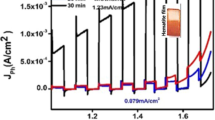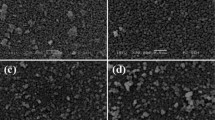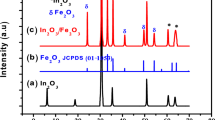Abstract
In searching for a suitable semiconductor material for hydrogen production via photoelectrochemical water splitting, α-Fe2O3 received significant attention as a promising photoanode due to its band gap (∼2.1 eV), good stability, low cost, and natural occurrence. α-Fe2O3 thin films were prepared by economic and facile dip coating method and subsequently subjected to an anodic potential of 700 mV versus Ag/AgCl in 1M KOH for different anodization times (1, 10, and 900 min) under illumination. X-ray diffractometry revealed increase in crystallites size from ∼31 nm for nanoparticles in pristine state to ∼38 and 44 nm after anodization for 1 and 900 min, respectively. A clear positive correlation between anodization time and grain (particle) size was observed from field emission gun scanning electron microscopy and atomic force microscopy (AFM); longer exposure time to anodizing conditions resulted in larger grains. Grain size increased from ∼57.9 nm in pristine state to ∼153.5 nm after anodization for 900 min. A significant smoothening of the surface with increase in anodization time was evident from AFM analysis.








Similar content being viewed by others
References
B. Klahr, S. Gimenez, F. Fabregat-Santiago, J. Bisquert, and T.W. Hamann: Electrochemical and photoelectrochemical investigation of water oxidation with hematite electrodes. Energy Environ. Sci. 5(6), 7626 (2012).
M. Grätzel: Photoelectrochemical cells. Nature 414(15), 338 (2001).
K. Sivula, F. Le Formal, and M. Gratzel: Solar water splitting: Progress using hematite (alpha-Fe2O3) photoelectrodes. ChemSusChem 4(4), 432 (2011).
M.J. Katz, S.C. Riha, N.C. Jeong, A.B.F. Martinson, O.K. Farha, and J.T. Hupp: Toward solar fuels: Water splitting with sunlight and “rust”? Coord. Chem. Rev. 256(21–22), 2521 (2012).
I. Cesar, K. Sivula, A. Kay, R. Zboril, and M. Grätzel: Influence of feature size film thickness and silicon doping on the perfomance of nanostructured hematite photoanodes for solar water splitting. J. Phys. Chem. C 113, 772 (2009).
A. Fujishima and K. Honda: Electrochemical photolysis of water at a semiconductor electrode. Nature 238(5358), 37 (1972).
A. Duret and M. Grätzel: Visible light-induced water oxidation on mesoscopic α-Fe2O3 films made by ultrasonic spray pyrolysis. J. Phys. Chem. B 109(36), 17184 (2005).
D.K. Bora, A. Braun, and E.C. Constable: “In rust we trust”. Hematite—The prospective inorganic backbone for artificial photosynthesis. Energy Environ. Sci. 6(2), 407 (2013).
A. Braun, K. Sivula, D.K. Bora, J. Zhu, L. Zhang, M. Grätzel, J. Guo, and E.C. Constable: Direct observation of two electron holes in a hematite photoanode during photoelectrochemical water splitting. J. Phys. Chem. B 116(32), 16870 (2012).
H. Dotan, K. Sivula, M. Grätzel, A. Rothschild, and S.C. Warren: Probing the photoelectrochemical properties of hematite (α-Fe2O3) electrodes using hydrogen peroxide as a hole scavenger. Energy Environ. Sci. 4(3), 958 (2011).
F. Boudoire, R. Toth, J. Heier, A. Braun, and E.C. Constable: Hematite nanostructuring using electrohydrodynamic lithography. Appl. Surf. Sci. 305, 62 (2014).
F. Le Formal, N. Tétreault, M. Cornuz, T. Moehl, M. Grätzel, and K. Sivula: Passivating surface states on water splitting hematite photoanodes with alumina overlayers. Chem. Sci. 2(4), 737 (2011).
S.R. Morrisons: The Chemical Physics of Surface (Plenum Press, New York, 1977).
R.R. Rangaraju, A. Panday, K.S. Raja, and M. Misra: Nanostructured anodic iron oxide film as photoanode for water oxidation. J. Phys. D: Appl. Phys. 42(13), 135303 (2009).
D.K. Bora, A. Braun, S. Erat, A.K. Ariffin, R. Löhnert, K. Sivula, J. Töpfer, M. Grätzel, R. Manzke, T. Graule, and E.C. Constable: Evolution of an oxygen near-edge X-ray absorption fine structure transition in the upper hubbard band in α-Fe2O3 upon electrochemical oxidation. J. Phys. Chem. C 115(13), 5619 (2011).
R.R. Rangaraju, K.S. Raja, A. Panday, and M. Misra: An investigation on room temperature synthesis of vertically oriented arrays of iron oxide nanotubes by anodization of iron. Electrochim. Acta 55(3), 785 (2010).
E.A. Garcla: Dynamical diffusion model to simulate the oxide crystallization and grain growth during oxidation of zirconium at 573 and 623 K. J. Nucl. Mater. 224, 299 (1995).
X-w. Wei and C-y. Chen: Influence of oxidation heat on hard anodic film of aluminum alloy. Trans. Nonferrous Met. Soc. China 22(11), 2707 (2012).
D. Graeve, H. Terryn, and G.E. Thompson: Influence of heat transfer on anodic oxidation of aluminium. J. Appl. Electrochem. 32, 73 (2002).
A.M. Abd-Elnaiem, A.M. Mebed, A. Gaber, and M.A. Abdel-Rahim: Effect of the anodization parameters on the volume expansion of anodized aluminum films. Int. J. Electrochem. Sci. 8, 10515 (2013).
A. Saijo, K. Murakami, M. Hino, and T. Kanadani: Effect of environmentally friendly anodization on the mechanical properties and microstructure of AZ91D magnesium alloy. Mater. Trans. 49(5), 903 (2008).
S. Chatman, C.I. Pearce, and K.M. Rosso: Charge transport at Ti-doped hematite (001)/aqueous interfaces. Chem. Mater. 27(5), 1665 (2015).
A. Yogi and D. Varshney: Cu doping effect of hematite (α-Fe2−xCuxO3): Effect on the structural and magnetic properties. Mater. Sci. Semicond. Process. 21, 38 (2014).
Y. Hu, D.K. Bora, F. Boudoire, F. Häussler, M. Grätzel, E.C. Constable, and A. Braun: A dip coating process for large area silicon-doped high performance hematite photoanodes. J. Renewable Sustainable Energy 5(4), 043109 (2013).
V.M. Aroutiounian, V.M. Arakelyan, G.E. Shahnazaryan, H.R. Hovhannisyan, H. Wang, and J.A. Turner: Photoelectrochemistry of tin-doped iron oxide electrodes. Solar Energy 81(11), 1369 (2007).
H-J. Ahn, M-J. Kwak, J-S. Lee, K-Y. Yoon, and J-H. Jang: Nanoporous hematite structures to overcome short diffusion lengths in water splitting. J. Mater. Chem. A 2, 19999 (2014).
Z. Liu, K. Wang, L. Xiao, X. Chen, X. Ren, J. Lu, and L. Zhuang: A morphology effect of hematite photoanode for photoelectrochemical water oxidation. RSC Adv. 4, 37701 (2014).
R. Schrebler, L.A. Ballesteros, H. Gomez, P. Grez, R. Cordova, E. Munoz, R. Schrebler, J.R. Ramos-Barrado, and E.A. Dalchiele: Electrochemically grown self-organized hematite nanotube arrays for photoelectrochemical water splitting. J. Electrochem. Soc. 161(14), H903 (2014).
H. Niu, S. Zhang, Q. Ma, S. Qin, L. Wan, J. Xu, and S. Miao: Dye-sensitized solar cells based on flower-shaped α-Fe2O3 as a photoanode and reduced graphene oxide–polyaniline composite as a counter electrode. RSC Adv. 3(38), 17228 (2013).
K. Gajda-Schrantz, S. Tymen, F. Boudoire, R. Toth, D.K. Bora, W. Calvet, M. Gratzel, E.C. Constable, and A. Braun: Formation of an electron hole doped film in the alpha-Fe2O3 photoanode upon electrochemical oxidation. Phys. Chem. Chem. Phys. 15(5), 1443 (2013).
A. Braun, Q. Chen, D. Flak, G. Fortunato, K. Gajda-Schrantz, M. Gratzel, T. Graule, J. Guo, T.W. Huang, Z. Liu, A.V. Popelo, K. Sivula, H. Wadati, P.P. Wyss, L. Zhang, and J. Zhu: Iron resonant photoemission spectroscopy on anodized hematite points to electron hole doping during anodization. ChemPhysChem 13(12), 2937 (2012).
K. Maabong, A.G. Machatine, Y. Hu, A. Braun, F.J. Nambala, and M. Diale: Morphology, structural and optical properties of iron oxide thin film photoanodes in photoelectrochemical cell: Effect of electrochemical oxidation. Phys. B 480, 91 (2016).
S. Heiroth, R. Frison, J.L.M. Rupp, T. Lippert, E.J. Barthazy Meier, E. Müller Gubler, M. Döbeli, K. Conder, A. Wokaun, and L.J. Gauckler: Crystallization and grain growth characteristics of yttria-stabilized zirconia thin films grown by pulsed laser deposition. Solid State Ionics 191(1), 12 (2011).
V.D. Mote, Y. Purushotham, and B.N. Dole: Williamson-Hall analysis in estimation of lattice strain in nanometer-sized ZnO particles. J. Theor. Appl. Phys. 6(6), 1 (2012).
Y. Caglar, S. Ilican, M. Caglar, F. Yakuphanoglu, J. Wu, K. Gao, P. Lu, and D. Xue: Influence of heat treatment on the nanocrystalline structure of ZnO film deposited on p-Si. J. Alloys Compd. 481(1–2), 885 (2009).
M.J. Jackson and W. Ahmed: Anodization: A promising nano-modification technique of titanium-based implants for orthopedic applications. In Surface Engineered Surgical Tools and Medical Devices, M. Jackson and W. Ahmed eds.; Springer: 2007; p. 21.
S-C. Shei, S-J. Chang, and P-Y. Lee: Rinsing effects on successive ionic layer adsorption and reaction method for deposition of ZnO thin films. J. Electrochem. Soc. 158(3), H208 (2011).
R.M. Cornell and U. Schwertmann: The Iron Oxides: Structure, Properties, Occurrences, and Uses (Wiley-VCH, 2003).
F. Li, L. Zhang, and R.M. Metzger: On the growth of highly ordered pores in anodized aluminum oxide. Chem. Mater. 10, 2470 (1998).
M.R. Belkhedkar and A.U. Ubale: Preparation and characterization of nanocrystalline α-Fe2O3 thin films grown by successive ionic layer adsorption and reaction method. Int. J. Mater. Chem. 5(4), 109 (2014).
S.H. Tamboli, G. Rahman, and O-S. Joo: Influence of potential, deposition time and annealing temperature on photoelectrochemical properties of electrodeposited iron oxide thin films. J. Alloys Compd. 520, 232 (2012).
V.M. Arutyunyan: Physical properties of the semiconductor-electrolyte interface. Sov. Phys. Usp. 32(6), 521 (1989).
ACKNOWLEDGMENT
This study was supported by Swiss-South African Joint Research (SSAJR) Project IZLSZ2-149031; the Swizz SNF grant R’Equip 206021-121306 and National Research Foundation of South Africa (NRF). K.M acknowledges University of Botswana for financial support. Y.H is grateful for financial support from and SNF Project No. 132126.
Author information
Authors and Affiliations
Corresponding authors
Additional information
This author was an editor of this journal during the review and decision stage. For the JMR policy on review and publication of manuscripts authored by editors, please refer to http://www.mrs.org/jmr-editor-manuscripts/.
A previous error in this article has been corrected, see 10.1557/jmr.2016.229.
Rights and permissions
About this article
Cite this article
Maabong, K., Hu, Y., Braun, A. et al. Influence of anodization time on the surface modifications on α-Fe2O3 photoanode upon anodization. Journal of Materials Research 31, 1580–1587 (2016). https://doi.org/10.1557/jmr.2016.53
Received:
Accepted:
Published:
Issue Date:
DOI: https://doi.org/10.1557/jmr.2016.53




